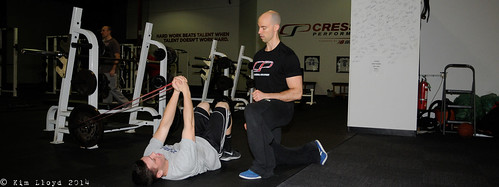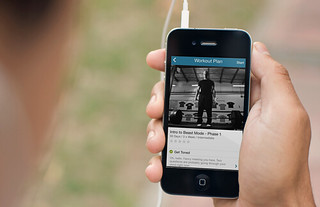What is the Tony Gentilcore Premium Training Group?
So glad you asked!
The Cliff Notes version: Far too many people go to the gym and think that just because they show up, they’ll magically get results. They feel that if they put in the time, they deserve the results, without considering the quality and goal of their training.
It just isn’t that easy.
While their intentions and heart are in the right place, where I see many people failing is that there’s no PURPOSE or INTENT in their training.
Worse still – many are just haphazardly roaming around the gym floor aimlessly performing a few bicep curls here and a few leg extensions there until their 60 minutes are up.
Sound a little familiar?
Well, I’m here to help. I want to be your coach!
I’ve recently teamed up with WeightTraining.com to offer the Tony Gentilcore Premium Group where I become your virtual strength coach and trainer.
I take over your training, take all the thinking out of your hands, and show you what it’s like to actually follow a well-structured, coherent, efficient, evolving, fun, and LONG-TERM program. You will get stronger, move better, look better, and feel like a million bucks.
Here’s a brief video – with what’s arguably the worst screen shot in the history of man-kind (can I look any creepier?) – explaining the whole concept as well as goals behind the program. Don’t worry: for those who would rather not listen for seven minutes, I’ll explain everything below.
Giving full disclosure: I understand that distance or online coaching means different things to different people. I’ll be the first to champion the sentiment that IN-PERSON training with a “good” trainer is ideal.
Being under the microscope or watchful eye of a good coach who can not only assess, but tweak technique with their athletes and clients is the gold standard.
BUT, and I say this a bit tongue-in-cheek, many trainers are flat our garbage. I can say this because not only do I observe garbage whenever I happen to train at a commercial gym, but I also spent the first five years of my career working with and observing said garbage.
I sometimes feel sorry for those people who don’t know any better and are paying good money – upwards of $70, $80, $90, sometimes more – per session t0 be shown how to put the pins in the proper place through a Cybex circuit or how to perform bicep curls on a BOSU ball. It’s borderline stealing, and more often than not the client would be better off flushing their money down the toilet.
I want to change that.
I am a good coach. Unlike many “internet gurus” out there, I actually train people for a living. Like, in person. I don’t just “claim” or write about training people. I’ve been training athletes and people from all walks of life for over ten years. My body of work – Co-founding Cressey Performance, speaking at various seminars and workshops, and my writing – speaks for itself.

Here’s what the Tony Gentilcore Premium Workout Group isn’t: It’s NOT the end-all-be-all of training programs.
It is going to be a kick-ass program for sure, and it’s going to help a lot of people……..but like any program , it has its limitations. Specifically, I have not evaluated you, and I will not be by your side while you train.
Here’s What It Is
My goal for this group is to create a community where you/we train our asses off, encourage one another, and have fun doing it. It is to provide goal-directed, structured, quality training for those who don’t have access to a “good” training or for those who can’t afford to have a trainer work with them individually.
This is more than just casually following The Six Pack Abs Workout or the WhoEvertheFuckCurrentActorJustGotJacked program.
This is about improving one’s life, taking the bull by the proverbial horns, and bringing out your inner beast mode.
Whatever that means is up to you, of course. For some it may entail training for health reasons. For others  maybe it’s working up to a 2x bodyweight deadlift. And even for others, it may be all about vanity.
maybe it’s working up to a 2x bodyweight deadlift. And even for others, it may be all about vanity.
But for everyone it’s also about the journey, the process, the moments when you’ll hate life (and me), and getting outside your comfort zone.
The truth is: we’re all human, and we like to do what we’re good at. This program is the opposite of that. It’s designed to make you do things that you “need” to be doing, and not necessarily what you “want” to be doing.
This group is going to be an ever-evolving “process”. Those who sign up will be at my mercy. What I say goes.
But don’t worry, I’ll keep things manageable. Ish.
Think of it this way: For what amounts to $1 per day or $2.50 per workout, you have me in your corner. There’s no time commitment and you can stay in the group for as long as you’d like.
What You Need To Do (<— This Is Important)
1. Go HERE and sign-up for the Tony Gentilcore Premium Workout Group on WeightTraining.com, and click on the “Join This Group” button.
Note: If you’re not already a member of the site, you’ll first sign-up for a FREE account. Don’t worry, it’s easy. Even a Jersey Shore cast member could do it!
2. From there you’ll enter the appropriate information (ie: credit card info, favorite color, etc)
Also………(and This Offer is Limited)
The first FIVE people who sign up and use the code TGWT2M will receive TWO MONTHS FREE. After that, the next TEN people who sign up and use the code TGWT1M will receive ONE MONTH FREE.
I have no idea how quickly those codes will last, so if you want to take advantage of them, act quickly.
I’ll be sure highlight when there are no more available.
UPDATE: All codes have been entered – but that doesn’t mean this still isn’t a good isn’t a good investment….;o)
3. From there you’re all set. God you’re smart. And good looking.
Some Miscellaneous Info and Tidbits
– Once you sign-up, not only are you an official member of the Tony Gentilcore Premium Group where you’ll have the opportunity to follow monthly programming written by yours truly, but you’ll also be given automatic access as a PRO-MEMBER to the entire site of WeightTraining.com, which offers a plethora of other programs and tools to use.
– In addition to being part of the TG community, you’ll also receive monthly tutorial videos solely for the group. As an example, in month one, I provide a video on proper front squat technique as well as discuss the rationale behind some of the “corrective” breathing drills that will be incorporated into the program.
There’s also talk of incorporating “hangout sessions” down the road where participants will have the opportunity to participate in a video chat and ask me questions pertaining to the program, any number of other fitness and training questions, or trying to figure out if I’m wearing pants.
– One cool feature is that you’ll be able to organize your workouts as you see fit according to your own weekly schedule, and WT.com will send you reminder emails of the days you’re supposed to workout. You know, to keep you accountable and stuff.
If you want to train on Monday, Wednesday, and Friday you can set the workout scheduler to that setting. If that doesn’t work, and you’d prefer other days, you’ll be able to tinker with the settings.
 Take Note: this won’t ALWAYS be a 3x per week program.
Take Note: this won’t ALWAYS be a 3x per week program.
My intention is to progress to a 4-5x per week program over time, and to “up the ante” as the months pass.
I’m a strength guy, and I want to get people strong.
– Moreover, for those with an iPhone, iPad, iPod, or iTouch, you can use the WeightTraining.com App to follow and log your workouts.
Don’t worry Android users: you won’t be left in the dark. The App will be available for you starting in April.
But even if you don’t have an Apple device or you’re anti-Apple, you can still print out the worksheets and keep track of your workouts the old-fashioned way.
– Like I said, it’s a COMMUNITY. The objective of the group is to train together, kick-ass, encourage one-another, leave comments, be competitive (if that’s your bag), and have fun!
Are you ready? Click the link below to get started!




